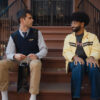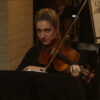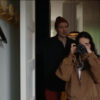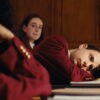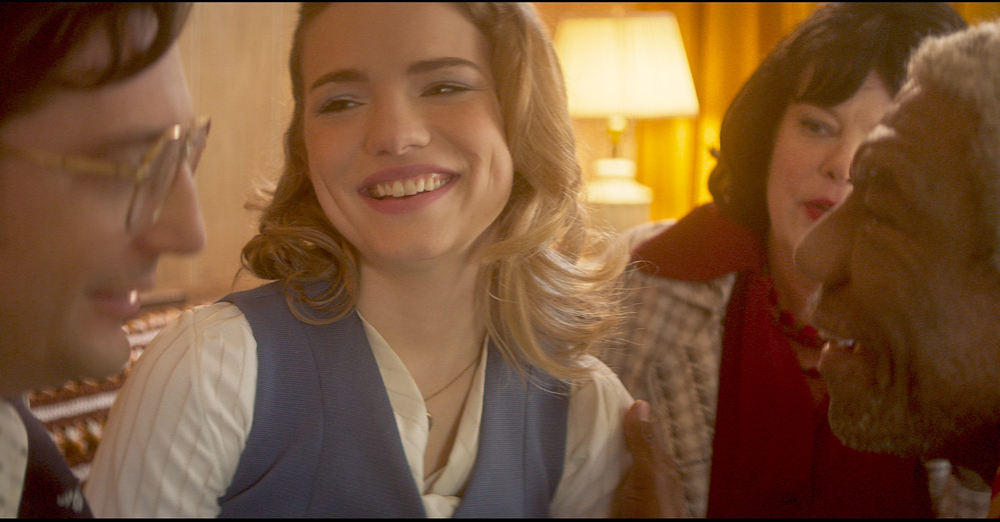Connie (Willa Fitzgerald) and Paul (John Magaro) are not young lovers on a romantic weekend retreat, despite all appearances in “18 1/2” though like any good love story they compliment each other well. Hiding out by the beach, the two check into a hotel as a pair of newlyweds, but in reality, she’s a skilled transcriptionist with access to recordings from the White House’s Office of Management and Budget and he’s a reporter from the New York Times and while listening to recordings from the Oval Office may seem like the unsexiest thing imaginable, both are turned on by the prospect of learning exactly what was on the missing 18-and-a-half minutes absent from tapes of conversations between Nixon and his chief of staff H.R. Haldeman that had to be turned over to the authorities during the Watergate scandal.
That things are not what they appear to be in the crafty comedy from Dan Mirvish ends up becoming an all too perfect analogy for how its production unfolded, with the director having to shut it all down four days away from finishing up in March of 2020 when the rest of the world went into lockdown because of COVID and becoming a bit of a test case upon its return for productions as it applied a whole new set of safety protocols on set. You’d never give a second’s thought to any of this in the finished film, in which the arrival of a peculiar pair of neighbors (vivaciously played by Vondie Curtis-Hall and Catherine Curtin) send chills down Connie and Paul’s spine as they are forced to pretend they’re a real couple to protect their cover, but Mirvish who previously spearheaded the creation of his own film festival after being rejected from Sundance – Slamdance, which continues to thrive nearly three decades later – naturally found a way to adapt to the unprecedented circumstances.
As it would turn out, a comedy that takes place almost entirely in one location with a limited amount of actors, using the beachfront outside the Silver Sands Motel in Greenport, New York and the luscious panoramic framing by cinematographer Elle Schneider to give it a sense of scale (not to mention a big, brassy bossa nova score), had Mirvish prepared for a pandemic shoot even before he could know one was on the horizon and although Connie and Paul may not make a clean getaway, the film emerges as a delightful bit of escapism. As “18 1/2” begins to roll out in theaters across the country this week, Mirvish spoke about how he and co-writer Daniel Moya found a new angle on this intriguing historical mystery, having the run of a motel for six months due to the generosity of its owner and how being prevented from crafting shots led to more invention when it came to the sonic elements of the film.
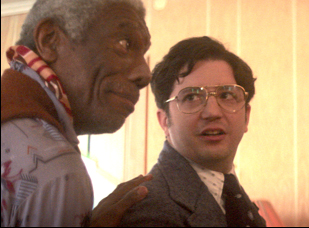
Yeah, it really did. I had been visiting with Jules Feiffer, who wrote [my last film] “Bernard and Huey,” in Shelter Island, which is just across the Potomac Bay across from the Silver Sands. And my friend Terry [Keefe] drove me to see Jules and we’d been talking a lot about Nixon and Watergate because this is literally the day after the 2016 election. [We] took the ferry back over to the Silver Sands and Terry showed me around. I had known about it, but I hadn’t visited and he said, “We’ve [had] a lot of fashion shoots for Vogue and that sort of thing and music videos, but no one’s ever shot a feature here and we’re closed in the winter. If you come up with an idea, everyone could stay here.” [Since] I had Watergate on the brain and this great location presented as an option, I just started ruminating about it from there. I always wanted to do something about Watergate and that era and I hadn’t cracked how and when to do it.
Working on “Bernard and Huey” was helpful too because that demystified doing period pieces. It’s kind of an old adage in film [that] doing period pieces is hard and expensive and you could never do it as well as Hollywood films, even if you tried. But about ten percent of “Bernard and Huey” are these flashbacks to the late ‘80s and we wound up doing them just fine – we found locations and costumes and turned my garage into a subway scene, and it got me over that mystification of how to shoot a period film on a budget for an indie film. I was like, “Oh, okay, if we can do that for ‘Bernard and Huey,’ we could shoot a whole film set in the ‘70s and we did.
It nods to the era its set in with the marriage of the long takes and the ultra-wide shooting style that really draw you in, but seems like it’s difficult to pull off practically. Was that challenging to get?
Some of it we experimented with a little bit in “Bernard and Huey,” doing some long takes there and even though I was working with different cinematographers for both films, we did a lot of research into ‘70s and late ‘60s filmmaking and the look and feel of especially the conspiracy thrillers, but also going back to “Carnal Knowledge” and my own influence from Robert Altman, who was my mentor on my first film. Something that’s always fascinated me about that era is his use of optical zooms, and they didn’t have the zoom lens, but if [a filmmaker] wanted to extend the zoom, they would do it in post-production optically and I think I was one of the last people at USC to use an optical printer built in the ‘40s, so it’s a technique I’ve always been fond of. Films have gotten away from that, or at least they try to hide them because what it does is it increases the size of the grain, but there are some subtle optical things that happen with an optic zoom and if you combine that with a real Zoom lens, you can get some nice effect.
The other thing that I found is that when you start working with your actors, that also tells you when you can do these long oners and when you can’t. Certain actors have certain rhythms and chemistries and combinations with actors where you know, “oh, okay, we can hold on this scene in a oner without having to cut around anything.” Then there’s other scene combinations of actors where you’re like, “This has to be shot and then edited in a different style.” That’s something I’ve figured out over time is that your actors can help inform your directing style.
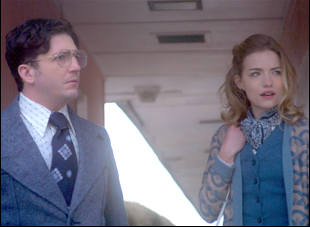
It did and in an ideal world, I’d like to have rehearsal time. On “Bernard and Huey,” we had three to four days of rehearsal with the whole cast in different combinations. On this one, it just wasn’t logistically possible, but the good part about that is then you get these very fresh reactions from the cast, which really worked to our advantage. When Vondie and Cathy were cast so late in the game, they just showed up and we went right into those scenes where Paul and Connie meet this strange, older couple and all of a sudden they’re thrust into this dinner situation [where they wonder] are they swingers? What are these people? And their reactions as actors was pretty true to their reactions as people to the situation. [laughs] It’s like, “Alright. Let’s just run with that” and we found these great surprises.
When there’s so much sound to react to on set, whether it’s the music they dance to or the recordings of Nixon, that you might not have until post-production, what did you play while you were filming?
We shot all the scenes with the recording of the tape in September 2020, but all the scenes where Connie and Paul are listening to the tape and then ultimately there’s the fight scene, those we all shot in March 2020. That was before we recorded Bruce [Campbell] and Jon [Cryer] and Ted [Raimi], so we did a scratch track version of it and it was actually me and Daniel Moya and our script supervisor one afternoon. We just sat and recorded the 18 1/2-minute gap, just to get the rhythm and the pacing of it. I think I played Nixon and then what we did was during rehearsals, we would just have that on an iPhone and we’d play it out loud, so the actors could respond to it.
But then during the takes, we didn’t want the sound of that to bleed over, so we actually had Daniel Moya because he was obviously familiar with the script and the recording, sit in a corner of the set, and it was really funny because with the camera moves, there’s literally almost no place to hide in that room, so we covered him with a blanket behind the TV and he would listen through headphones to this recording of the tape that we had done and then he would yell out these specific one-word cues, like, “Table!” or “Liddy!” that would prompt these specific reactions from John and Willa. Two days ago, I went back and listened to some of those takes and it’s very funny because you’re watching it and all of a sudden you’re hearing this disembodied voice yell out “Floor,” or “Couch!” But that’s how we could use the real sound from the room — we’d just have to duck out these strange utterances from the disembodied voice, but it kept the timing consistent from take to take.
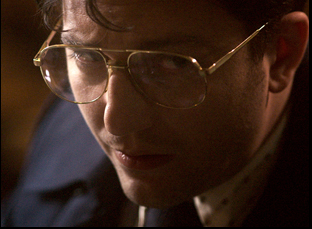
Obviously there was huge disappointment and tears and a sense of the unknown, but as soon as we figured out, “Okay, this is going to be a few months and we’ll probably be able to get back in one way or another,” [we thought] “What can we do during that time?” Within a month or two we’re like, these voice actors are sitting at home, not shooting anything right now [since] every production around the world had shut down. Most of them had microphones or a similar set-up, so we were able to record them basically on Zoom sessions and they were all in different places. Originally, we planned to do all that during post-production and frankly, it would been expensive and challenging to get everyone to come to a studio all at once, so this allowed us to do it pretty easily and [when] we would do these Zoom sessions, they would simultaneously record onto either a Quicktime file or some other slightly higher quality audio version and send me those files, but by doing it on Zoom, the actors could look at each other, I could look at them and it worked out great and we had terrific audio quality.
Then simultaneously I was working with Luis Guerra, my composing partner, and he actually lives a few blocks away from me, but still we did most of it remotely and likewise, there were musicians all around the world that couldn’t do live gigs for a while. [Luis] is like, “Well, I’m stuck in Mexico City and I’ve got these other horn guys here. Why don’t we have a whole horns section?”so that’s something that probably wouldn’t have happened if there hadn’t been a pandemic. When we got Caro Pierotto, who’s our featured vocalist, she hadn’t performed live in months and we realized she could come into Luis’ studio and in an isolation booth, she didn’t need to wear a mask because it was a sealed off room and she [said], “Oh my gosh. This is great. I can sing again.” So we could work that way safely and also the time allowed Luis and I to probably write more music than we would’ve otherwise, so we used that time to the best of our advantage.
From what I understand there were still four days left of filming when you wrapped initially. What was it like just to get back on set?
It was weird, but in a good way. A third of the crew ended up staying at the Silver Sands for two months of quarantine after shot. These are kind of the single Brooklynites that didn’t have families to go back to and Terry let them stay at the Silver Sands because at that time, Silver Sands was safer than any place in New York. Our cinematographer Elle Schneider ended up staying for all six months [between the end of production and restarting]. She never went home. So it was funny when I got back there and I was the one person from L.A. that was coming back in the September shoot. New York had a two-week quarantine for Californians, so I stayed in one of those cabins for two weeks and Elle and Terry were still there and I brought my Sourdough starter with me and started baking sourdough every day on the east coast.
But it was strange because we were one of the first films to come back into production with the SAG and DGA protocols, but those were still kind of getting worked out as far as when and where to get tested. That was a real challenge for us because we were so far out of New York City and the average was a ten-day turnaround time on PCR tests, but SAG needed it within 24 hours, so we’re like, “Uhh…so where are we supposed to do this?” We ended up developing relationships with local hospitals, one in New York City, one out in Greenport and worked closely with them and we shared that information with other productions later. The whole process was very strange because suddenly you’re wearing these masks and normally, on a film production, you’re supposed to whisper film direction to the actors between takes, but you can’t get close to them, so you’ve got to yell direction for all the other cast and crew to hear, or during a take where you would [discretely] tell the first AC to rack focus or to the cinematographer to pan left or pan right. That gets awkward.
It led to some very funny situations where someone would be wearing a mask in the take because everybody had gotten so used to everybody wearing masks by then that everyone would forget and you’d be shooting for 10 seconds and someone would say, “Hang on a second, that person’s wearing a mask. That can’t be right.” There would be weird things like that, but we were also very lucky because the rules were very strict at the time that actors couldn’t get close to one another. We were very lucky. We had already done all the kissing scenes, dancing scenes, fighting scenes, all the scenes where the actors needed to be intimately close, and we didn’t have any crowd scenes. That was a problem affecting a lot of productions, figuring out what to do about extras, but thankfully the nature of the film, we never had to worry about that.
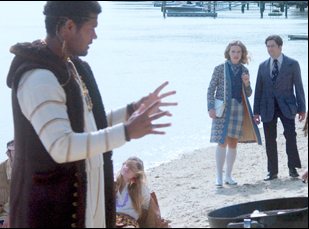
Yeah, most film festivals during that first year of the pandemic had gone almost completely virtual and luckily the timing worked out that we were still working on post-production, so it’s like “Okay, great,” and then the Delta [variant] happened at the end of the summer last year, so a lot of film festivals were kind of taken by surprise by that and a lot of them this past year had hybrid versions where they would do live screenings plus online screenings and then there was another round with Omicron, so by luck and somewhat by design, we pretty much aimed almost exclusively for live festivals. I called them trough fests in the fall. There was a period of about two months in that trough between Delta and Omicron variants and we played at 10 festivals, nine of them had live screenings and someone from the production went to all of them. I went to most of them, but Elle Schneider was at Tallgrass, representing the film there and it was great because we won that, and Luis, our composer, went to our international premiere at the Sao Paulo Film Festival.
I was able to go to most of them and this spring I was able to go to most of the festivals and that included some pretty nice ones – in Barbados and Manchester, where I won the best director prize and this was a new trough — between Omicron and World War III, so there was a nice little window of a month or two or three where we could screen the film to real audiences, which for a lot of people, including myself, was our first time seeing any film with any audience in a year-and-a-half. It makes you appreciate that a big reason we have movies is to see the film as a communal experience and to laugh together or cry or gasp and it really was fun because normally when you’re on post-production with a film, you do a few test screenings and that may just be with a dozen or so people, but you get a little bit of a sense of this line is getting laughs and this one isn’t. In our case, we couldn’t do any communal test screenings.
I could send work-in-progress cuts to individual people and get comments from friends, but it really wasn’t until our premiere at Woodstock, which was the first time any of us had seen it with an audience that it was like, “Oh my gosh, people are laughing out loud at some things [we] hadn’t appreciated as being as funny as they were,” which was great. I kept thinking the film was more of a dark comedy and people were like, “Oh no, there’s some real laugh out loud moments or cringe laughs,” depending on the moment, so you don’t always know what you have until you share it with an audience, which is nice. That’s the thing people forget about filmmaking is you can make whatever you want, but the final element of filmmaking is film viewing. It’s how you engage with an audience and what their reaction is is the final part of the process. That’s why it’s so nice to be able to have a theatrical release of the film now.
“18 1/2” opens on May 27th in New York at the IFC Center and the Film Noir Cinema, Los Angeles at the Laemmle Monica, Bridgton, Maine at the Magic Lantern and Hollywood, Florida at the Cinema Paradiso before expanding on June 3. A full list of theaters and dates is here.
